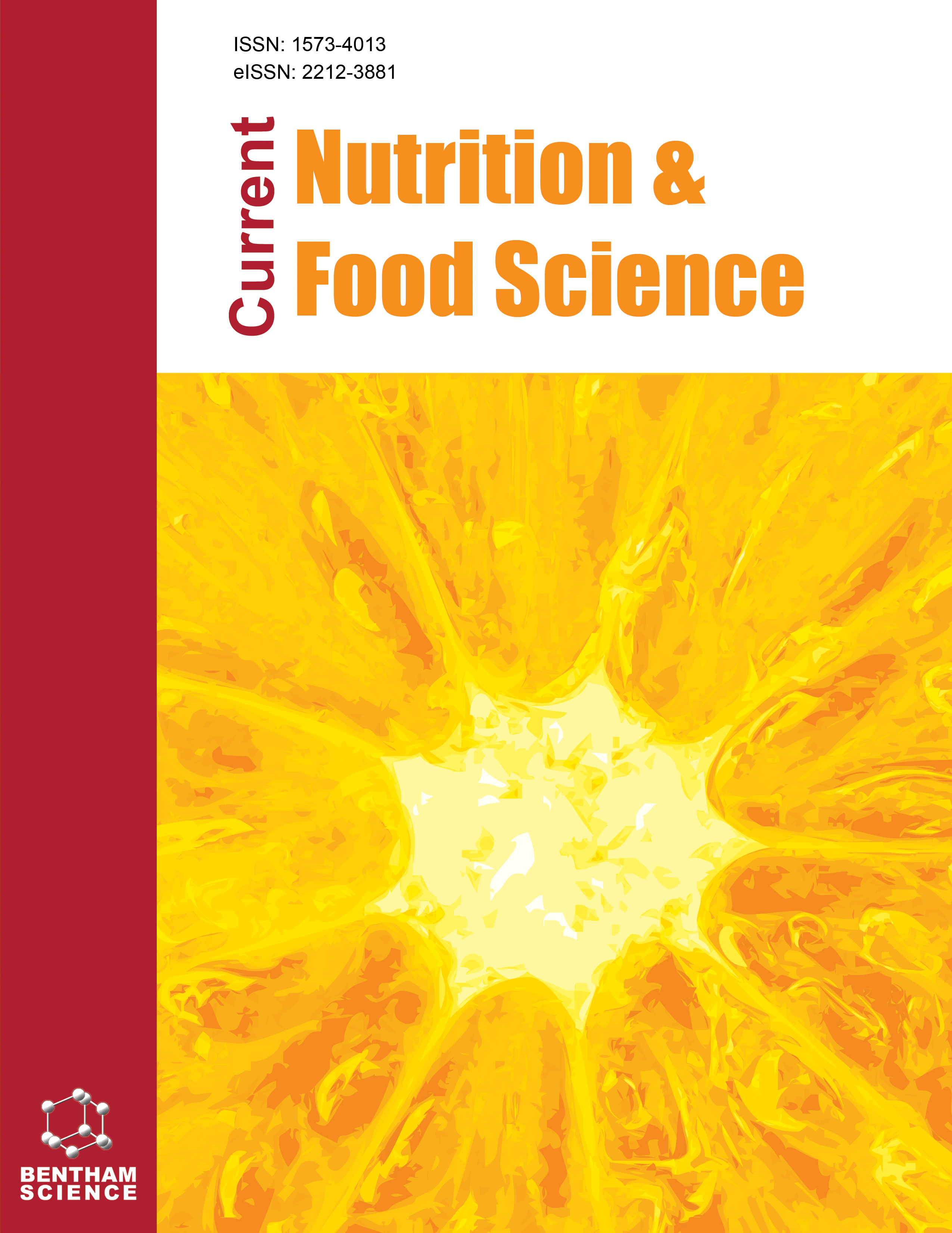- Home
- A-Z Publications
- Current Nutrition & Food Science
- Previous Issues
- Volume 9, Issue 4, 2013
Current Nutrition & Food Science - Volume 9, Issue 4, 2013
Volume 9, Issue 4, 2013
-
-
Functional Foods Market and Consumer Perspective
More LessAuthors: Azzurra Annunziata and Riccardo VecchioThe current paper reviews published academic research on European consumer attitudes towards Functional Foods (FFs). The main goal is to rationalize the vast existing body of evidence on consumers’ understanding and use of FFs and identify further interesting research avenues. Almost all the studies analyzed in the current review reveal that consumer acceptance of the concept of FFs together with a better unde Read More
-
-
-
Bioaccessibility of Functional Ingredients
More LessAuthors: Aoife L. McCarthy and Nora M. O’BrienBioaccessibility is defined as the amount of a food constituent transferred to the micelle fraction after digestion in the gut, when compared with the original amount of the constituent present in the food. Bioaccessible constituents may be able to pass through the intestinal barrier and hence become bioavailable within the body. Bioaccessibility is commonly determined by in vitro methods simulating the human digestion and is Read More
-
-
-
Bioactive Fish Fatty Acids: Health Effects and Their Use as Functional Food Ingredients
More LessAuthors: Deborah Pacetti, Massimo Mozzon, Paolo Lucci and Natale G. FregaThe nutritional benefits of fish or fish oil consumption lies predominantly in its advantageous fatty acid profile, which is rich in long chain omega-3 polyunsaturated fatty acids (ω3 PUFA). Evidence from a large number of epidemiological studies, clinical studies and intervention trials have established the protective effect of ω3 PUFA against several diseases. New experimental evidence also indicates the presence in fish oils Read More
-
-
-
Phytochemicals and Antioxidants: An Evaluation in Understanding the Human Lifeline
More LessAuthors: Umesh C. Gupta and Subhas C. GuptaThe word phyto means plant in Greek. The term phytochemicals means “plant chemicals” and these include compounds such as flavonoids, beta-carotene, chlorophyll and anthocyanins that occur naturally in plants. Sometimes they are also called “phytonutrients”, especially where a health role for a phytochemical has been established. Vegetarian diets are rich in phytochemicals and antioxidants. These chemical substances Read More
-
-
-
Development of a Fermentation Process for Utilization of Emblica Officinalis Gaertn (Amla) Candy Waste for Production of Natural Vinegar
More LessEmblica officinalis Gaertn (amla) fruit while being processed into candy by food processing industry generates a high brix candy syrup which otherwise is a waste and poses burden to environment. This candy syrup was converted into natural vinegar, a nutrient rich value added food product through two successive fermentations: alcoholic and acetic acid fermentations. Diluted candy syrup (20°Bx) supplemented with Read More
-
-
-
Effect of Frozen Storage on Quality Changes of Five Fish Species from South Caspian Sea
More LessAuthors: Mohammad Ali Sahari, Safura Pirestani and Mohsen BarzegarFish and fishery products can undergo undesirable changes during frozen storage and deterioration may limit the storage time. These changes result from lipid oxidation and enzymatic hydrolysis of lipid and protein. Approach: The quality changes (total lipids, primary and secondary lipid oxidation products as well as lipid and protein hydrolysis) in Caspian kutum, golden grey mullet, common carp, pike perch, and common Read More
-
-
-
Effect of Conventional and Microwave Toasting on Sinapic Acid Derivatives and Canolol Content of Canola
More LessAuthors: Shyamchand Mayengbam, Rabie Khattab and Usha Thiyam-HollanderCanola seeds were subjected to conventional and microwave heat treatments to investigate changes in the phenolic profile of defatted meal and oil obtained from the toasted seeds. Different temperature (120–200 °C) and time (5–20 min) combinations were applied for toasting the seeds in a conventional oven. The seeds were also toasted using a microwave oven at 300 Watt power level with and without steaming. Phenolics Read More
-
-
-
Quality and Shelf-Life of Cold Stored Mullet Fish (Mugil Cephalus) Pretreated by Sorbate/Thyme Oil with Emphasis on Biogenic Amines
More LessAuthors: Ali R. Shalaby, Robiel K. Moawad, Wafaa H. Emam and Gamal F. MohamedThe effect of treatments of whole ungutted mullet fish (Mugil cephalus), by sorbate, thyme oil and their combination prior to cold storage (3-5°C), on quality attributes, biogenic amines and shelf-life was followed. Microbial growth was significantly reduced during cold storage as a result of pretreatments. Protein deterioration reactions, lipid oxidation, and other chemical responsible for fish spoilage were also significantly de Read More
-
-
-
Interaction of Tamarind Kernel Powder, Gum Arabic and Maltodextrin in Aqueous Solution and Microencapsulated Systems
More LessAuthors: Pitchaon Maisuthisakul and Thepkunya HarnsilawatThe combination of polysaccharides as wall materials affects the stability of microcapsules. One of several factors influencing the stability is related to interaction between polysaccharides. The interaction of tamarind kernel powder, gum arabic and maltodextrin was obtained by UV-Visible spectrum and apparent viscosity in solution and on the aggregation of the W/O/W emulsions from encapsulation efficiency, creaming ind Read More
-
Volumes & issues
-
Volume 21 (2025)
-
Volume 20 (2024)
-
Volume 19 (2023)
-
Volume 18 (2022)
-
Volume 17 (2021)
-
Volume 16 (2020)
-
Volume 15 (2019)
-
Volume 14 (2018)
-
Volume 13 (2017)
-
Volume 12 (2016)
-
Volume 11 (2015)
-
Volume 10 (2014)
-
Volume 9 (2013)
-
Volume 8 (2012)
-
Volume 7 (2011)
-
Volume 6 (2010)
-
Volume 5 (2009)
-
Volume 4 (2008)
-
Volume 3 (2007)
-
Volume 2 (2006)
-
Volume 1 (2005)
Most Read This Month
Article
content/journals/cnf
Journal
10
5
false
en


